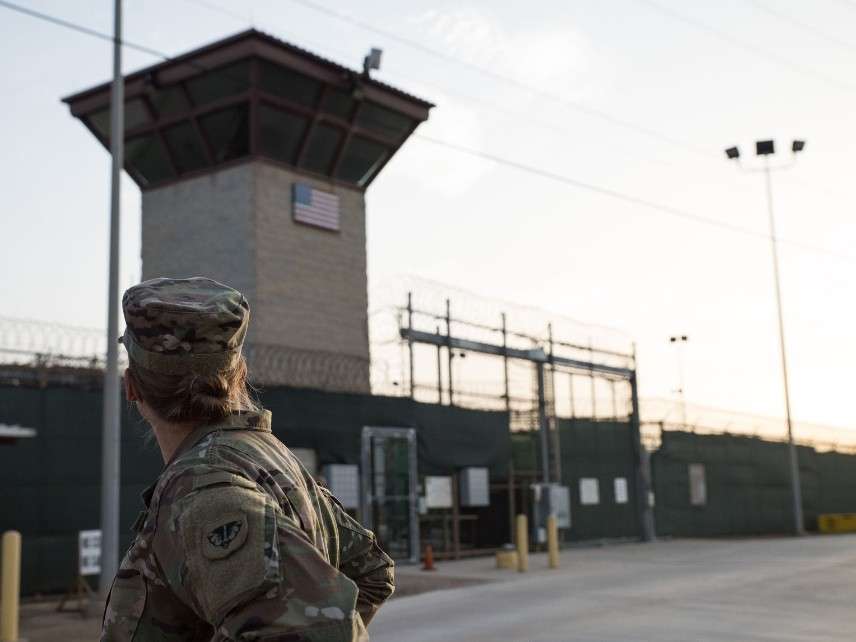Gitmo Preps for an Upgrade
This monument to the war on terror is still open, and it's costing taxpayers a fortune.

Whether the U.S. manages to broker a peace with the Taliban or not, one legacy of the war on terror remains—the prison at Guantanamo Bay (also called Gitmo). At its height, this symbol of Bush administration power held 600 people. And as miserable as the infrastructure reportedly is down there, its commander, Navy Rear Admiral John Ring, says he could fit 200 more people if given an increase in the same number of soldiers. He'd rather have an influx of money, however.
So there were once 600 prisoners. Now there are only 40. Forty people being watched over by 1,700 soldiers. Forty people who have been held in limbo for going on two decades now. Some of them, such as Khalid Sheikh Mohammed, are clearly mass murderers who should still have their trial (and if he ever does, the torture he suffered will be a terrific coup for his defense). Others linger in prison, not charged, not freed, and generally making a mockery of the whole American concept of a speedy trial. The spooky thing is how comfortable the country became with letting people stay in prison without trial.
You might recall that President Obama made a campaign promise to close Gitmo. His efforts petered out once people realized criminal trials of the remaining detainees would take place in the continental U.S. And in fact, the public—particularly the Republican public—has long been opposed to shutting the place down and letting detainees face trial. Obama clearly had little interest in using his political capital on forcing the issue. Now, President Trump heartily supports the prison, and the most recent omnibus spending bill involved a heaping $115 million just for permanent troop barracks (plus more than $85 million in other costs).
Under Trump, neoconservatives are beloved allies, and worrying about Gitmo is so early aughts. But it's still there. In fact, the U.S. appears to be taking the idea of sending a fresh crop of 50 or so accused ISIS fighters (out of nearly 1,000) there, particularly if the American withdrawal from Syria actually goes through.
The military preference is to send suspects back to their country of origin, and have them be prosecuted there. However, that obviously doesn't always work out in a war not fought against nation states. Plus, dependable warmongers of today, including Sens. Tom Cotton, Ted Cruz, and Marco Rubio want to add some fresh ISIS blood to Gitmo. This is in spite of the potential for the whole thing to backfire on hawks. A 2017 Heritage Foundation study cautioned that ISIS prisoners would have a particularly strong case against being held there, thanks to the legality of the war against them being itself on shaky—or at least unchallenged—ground. Whether ISIS fighters end up in Gitmo or not, Trump is not likely to be worrying about whether the 2001 Authorization for Use of Military Force legalizes the war against ISIS. However, the current plan is that Guantanamo Bay will continue operating for the next two and a half decades. It seems unlikely that most or even many prisoners will get a trial during that time.
If the problem of indefinite detainment doesn't strike your fancy, or you're just used to it by this point, there's always the fact that Gitmo is appallingly expensive. In 2017, the American Civil Liberties Union reported that the prison costs $454 million to operate every year. In 2013, that amounted to $11 million for every prisoner. Since it opened, the prison has cost taxpayers nearly $5 billion.
Another strange-to-comprehend cost is the looming fact of Gitmo's population aging. According to NBC, detainees' "average age is 46, and one is now 71." As expensive as the prison is for taxpayers, the reality is that government-funded elderly prisoner care is always going to come at an insane cost. The secretive Camp 7, home of the most 15 most valuable prisoners, is reportedly in the worst kind of shape, and is cracking and sinking. Congress has doled out money for a medical center for detainees, and for various resources to keep troops moderately well-fed and clothed. However, they refuse to approve funds for new facilities for detainees. Unsurprisingly, most of the more than $350 million Congress has set aside for Gitmo is for the benefit of the base, not the actual prison.
For those who believe Gitmo to be a humanitarian and civil liberties horror, it's difficult to know what to support. Inhumane conditions are not acceptable, but the absurdly bloated costs are also wildly unnecessary.
Congress could give Gitmo the $69 million Ring says they need to make a cheaper, more sustainable prison. Or they could withhold it and let these unsympathetic rogues age and suffer indefinitely. But we don't need to waffle, Obama-style, because Trump has declared Gitmo an "enduring mission" that will last long after his presidency. This is another legacy of the war on terror that we can't rid ourselves of, or even begin to imagine that such a thing is possible.

Show Comments (30)